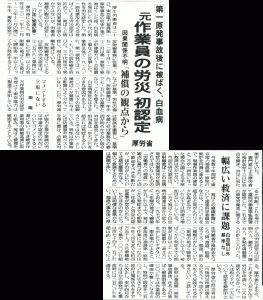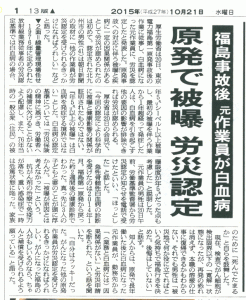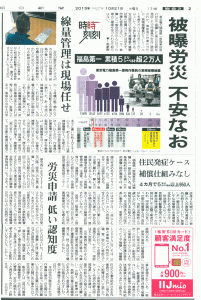Original Japanese written by staffer
The English below translated from the original Japanese by Heeday
The English translation edited by Rev. Dr. Henry French, ELCA
(Source: articles of October 21st, 2015 editions of the Fukushima Minpo and Asahi Shimbun newspapers)
▼Click each image to enlarge it and read the caption.
Japan’s Ministry of Health, Labour and Welfare, on October 20th, announced that it had certified an ex-worker—who worked at TEPCO’s Fukushima Daiichi NPP after the disaster and who developed leukemia—as qualifying for worker’s compensation. This was the first case ever of such certification which recognized a cause-effect relationship between exposure to radiation caused by a NPP accident and a disease.
According to the certified ex-worker, a 41-year-old male resident in the City of Kitakyushu, he was engaged in structural installation and welding around Units 3 and 4 of Fukushima Daiichi, in 2012 to 2013, as a worker employed by a business partner of TEPCO. Then, in January 2014, he was diagnosed with acute myelocytic leukemia. His accumulated exposure dose was around 15mSv from Fukushima, and an additional 4mSv or so from Kyushu Electric Power’s Genkai NPP, where he served during a regular checkup for around three months in 2012.
The certification needed to qualify for worker’s compensation for leukemia requires that the worker had an annual exposure dose of 5mSv or more, his/her leukemia emerged at least one year after the last exposure, and there was no evident cause of the leukemia other than the exposure at work.
According to epidemiological studies of NPP workers, conducted by a public-interest, incorporated foundation called the Radiation Effects Association, and other groups, 34 such workers lost their lives due leukemia with their accumulated exposure dose at 10mSv or more between 1990 and 2009. More than 60 other workers passed away due to stomach, lung, or other cancer after accumulated exposure of 100mSv or more,.
As of the end of August 2015, more than 20,000 people had accumulated exposure of 5mSv or more working at Fukushima Daiichi after its disaster. This number will keep rising. To win worker’s compensation certification, a worker is required to know his/her exposure dose, health state, etc. Such information, however, is often not available to many workers. Furthermore, the application procedure for the certification is not easy.
Moreover, there is currently no legal framework for providing compensation to any common resident who has been exposed to radiation, even if he/she has developed cancer and pays for his/her own medical expenses and takes leave from work. A survey of some 460,000 residents of Fukushima Prefecture estimated that some 950 residents, excluding NPP workers, had an exposure dose of 5mSv or more during the four months following the Fukushima Daiichi disaster.
Dr. Saburo Murata, vice director of Hannan Chuo Hospital, is an expert in radiation exposure control for NPP workers. Says the doctor, “Those workers take some measures to protect themselves from radiation, though such measures are mostly insufficient. Their exposure doses are measured. On the other hand, common residents are exposed to radiation without any protective measures, and their doses are not controlled. There should be a legal framework to grant them compensation for leave from work and treatment for lower doses of exposure than those of NPP workers.”
For residents in Fukushima, much of their anxieties concerning radiation are about their future health. The Japanese government must establish a legal framework to provide compensation for health hazards from radiation, regardless of whether the victims are NPP workers or common residents. Otherwise, the government would be acting irresponsibly in restarting existing NPPs.



